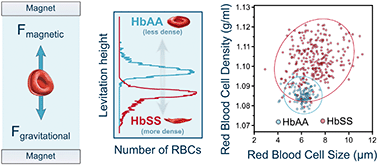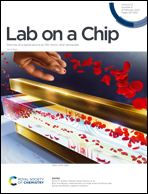Size and density measurements of single sickle red blood cells using microfluidic magnetic levitation†
Abstract
Single cells have unique biophysical signatures that can rapidly change during various disease states. For instance, cellular density is an inherent property differing between cell types. Characterizing changes in fundamental density properties down to the single-cell level can reveal sub-populations in pathological states. Here, we have developed a microfluidic, magnetic levitation-based assay (MagDense) that detects minute density differences of individual red blood cells (RBCs) down to 0.0001 g mL−1 resolution. This assay fractionates RBCs based on their density profiles in a non-ionic paramagnetic medium flowing in a capillary microchannel placed between magnets with same poles facing each other. Based on precisely measured levitation height and density of individual RBCs at their specific equilibrium state, we demonstrated that MagDense can accurately analyze the density of sickle hemoglobin (HbS)-containing RBCs and normal hemoglobin (HbA)-containing RBCs. In addition, the precise density and cell size measurements at the single cell level showed three different sub-populations of RBCs in blood samples from individuals with homozygous sickle cell disease receiving blood transfusions; where less dense, HbA-containing RBCs levitated higher, while the denser, HbS-containing RBCs levitated lower. We compared the mean RBC densities of sickle cell disease subjects with healthy controls and found distinctly separated bands of RBC density for each group denoting the likely range of cell densities seen in the blood samples. The high resolution of our method enabled measurement of deviation from the mean RBC density. Moreover, we introduced a new term as a measure of density dispersion, “RBC levitational density width, RLDW”. Mean RBC density in sickle cell disease associated with hemoglobin from complete blood count (p = 0.032, linear regression) and RLDW associated with absolute reticulocyte count (ARC) and RBC distribution width (RDW) from complete blood count (p = 0.002 for ARC and p = 003 for RDW, linear regression). Our magnetic levitation-based assay enables rapid, accurate, density-based imaging, profiling and label-free monitoring of single RBCs. Our approach can be broadly applicable to investigate blood cell disorders and the effects of emerging pharmacological and curative therapies in patient outcomes.

- This article is part of the themed collection: Microfluidics for hematology


 Please wait while we load your content...
Please wait while we load your content...